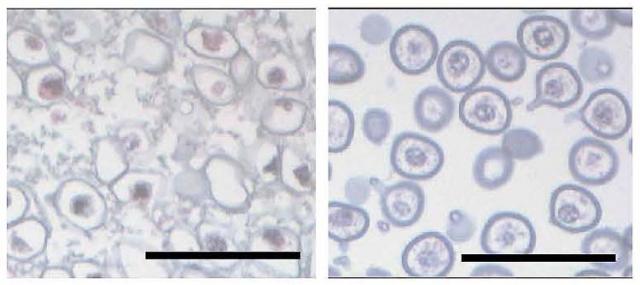Home > Research > Research Results > Research Results 2019 > Elucidating the mechanism that renders Japanese cedar (sugi) pollen-free
Update:August 6, 2019
Main content starts here.
Elucidating the mechanism that renders Japanese cedar (sugi) pollen-free
| Article title |
Comparison of fertile and sterile male gametogenesis in Cryptomeria japonica D. Don |
|---|---|
| Author (affiliation) |
Norihiro Futamura(a), Tomohiro Igasaki(a), Maki Saito(b), Hideaki Taira(c), Kenji Shinohara(d) (a) Department of Forest Molecular Genetics and Biotechnology, FFPRI, Tsukuba, Ibaraki, Japan. (b) Toyama Prefectural Agricultural, Forestry and Fisheries Research Center; Forestry Research Institute, Tateyama-machi, Toyama, Japan. (c) Ex Niigata University Graduate School of Science and Technology, Biosphere Course,Niigata, Japan. (d) RIKEN Center for Sustainable Resource Science, Wako, Saitama, Japan. |
| Publication Journal |
Tree Genetics & Genomes、Springer、 15(3):30、April 2019 DOI:10.1007/s11295-019-1335-8( External link ) |
| Content introduction |
Japanese cedar (sugi) pollinosis is considered to be a national affliction and represents a serious social issue. Therefore, pollen-free cedar trees that do not scatter pollen are currently under development. Pollen-free cedar trees (Toyama 1 mutant; Fig. 1) were first discovered in Toyama Prefecture in 1992; however, the exact mechanism that rendered these trees pollen-free was unclear. In Toyama 1 mutant species, we observed abnormalities in the formation of the endexine, an inner membranous layer of the pollen exosporium (Fig. 2). The analyses of the expression levels of more than 22,000 genes during pollen formation in Toyama 1 mutants revealed that the expression levels of 32 genes were significantly lower in Toyama 1 mutants compared with that in normal species during pollen wall formation. Detailed analyses of sequences and expression patterns of the genes showed that these genes included ones that could be involved in processes, such as transcriptional regulation, signal transduction, and protein modification. Thus, the results of this study indicated that Toyama 1 mutant is a pollen-free variety because of abnormalities in the process of pollen wall formation. To date, several Japanese cedar varieties that differ in the mechanism of pollen-free have been identified. Further studies on the mechanisms that render Japanese cedar varieties pollen-free will be helpful for the identification of the causative gene and the development of pollen-free cedar trees in the future.
Figure 1. A Toyama 1 mutant (left) with mutations for pollen-free and a normal cedar (right). Normal species scatter pollen, whereas the pollen-free species are unable to do so.
Figure 2. Abnormalities in the endexine formation process in a pollen-free Toyama 1 mutant (left). The development of pollen walls, as found in the normal species (right), was not observed in the Toyama 1 mutant. The scale bar represents 0.05 mm. |
Copyright © Forest Research and Management Organization. All rights reserved.


